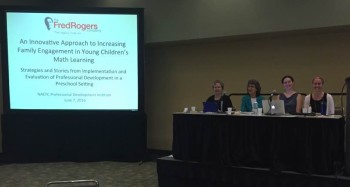By Jennifer Borland and Camellia Sanford-Dolly
Over the last decade, Rockman et al has led several studies to independently evaluate Ready to Learn (RTL) programming, both formatively and summatively. We were pleased to learn that some of our evaluation work contributed to a comprehensive meta-analysis of research on Ready to Learn programming recently published in Child Development. The full article is available for purchase, and the study’s author, Lisa Horowitz, Ph.D. has also provided an informative blog post about the study. As reported in her blog, a key finding of the meta-analysis is that overall, RTL media was “successful in promoting early literacy, especially vocabulary and …knowledge of English letter sounds,” and further, “Exposure to RTL media resulted in about 8 percentiles or 1.5 months of literacy development above and beyond typical growth.” In the spirit of making research on RTL media more accessible and available to the public, we wanted to share a couple of our reports produced for and about products that received funding from RTL.
Evaluation of Super Why and Martha Speaks, (PBS: Raising Readers Mobile App Study, 2010): This study found some pretty respectable gains among users over a two week period playing two apps: Super Why and Martha Speaks: Dog Party. Rockman et al was commissioned by PBS KIDS to assess learning outcomes and usage patterns among 3-7 year olds. Ninety iPod Touch devices were given to groups of 3-7 year old children from two Title I Schools – one in Washington D.C. and the other in Bloomington, Indiana. The children were asked to use two Apps: Super Why and Martha Speaks: Dog Party, featuring characters and content from the popular television shows, for a two week period during the spring of 2010. Parents were asked to submit daily observation forms and complete short pre- and post-study surveys. Children were given pre- and post-study tests to assess ability in reading skills and content areas covered in the Apps. REA developed customized instruments to test gains based on specific vocabulary and concepts presented in each app, and found that gains were indeed noticeable, in instances where kids were at the right developmental point to learn those words/concepts. Findings were shared as part of the “Learning: There’s an App for that!” report produced by the Joan Ganz Cooney Center.

Evaluation of Peg + Cat Early Learning of Math Through Media Project (2013-2017), with funding from the National Science Foundation (NSF) Advancing Informal Science Learning (AISL) program. Peg + Cat is an award-winning PBS television series, produced by The Fred Rogers Company, in which a girl, Peg, and her companion, Cat, solve everyday problems using mathematics concepts. To extend the show’s core messages, the Peg + Cat team developed supplementary resources, including professional development (PD) mathematics modules for early childhood educators, classroom-based family engagement activities for teachers to implement with parents and children, take-home materials for families, online games, mobile apps, and additional episodes of the Peg + Cat television series. As external evaluators for the project, our methods included observations of teachers’ professional development, classroom activities, and family engagement activities, as well as interviews with parents, teachers, and project team members, and surveys of teachers and parents, including family forms to track project resource use. We found that the project’s transmedia approach increased teachers’ confidence in and knowledge about their mathematics instruction, parents’ engagement in activities and conversations with their children around math, and children’s positive and persistent attitudes towards math, as reported by their parents. Teacher outcomes were mediated by their use of project resources. Most parent and all child outcomes were mediated by teacher confidence, teachers’ use of project resources, and parents’ use of transmedia resources. In sum, transmedia was a pervasive thread that gave teachers, parents, and children an approachable and fun way to experience math together. The full summative evaluation report is available here.